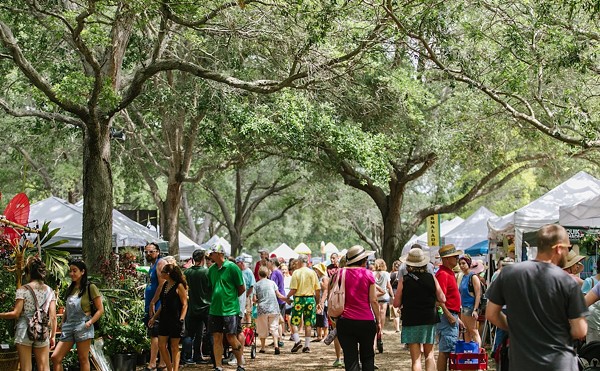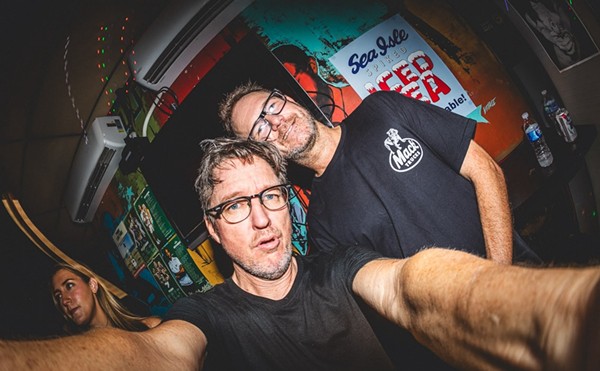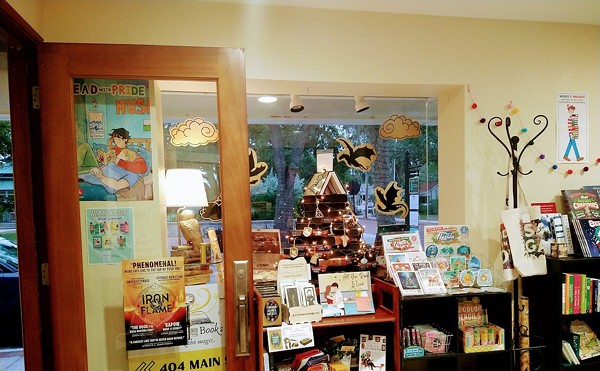After our conversation, I woke up the next morning with the overwhelming need to put on perfume and make guns.
I know what you're thinking — honey, I've been there — but artist Renée Stout woke up with that feeling and then actually made the guns. Six of them, out of wood and metal and dedicated to her favorite revolutionaries. Abolitionist Harriet Tubman got an antique one-shot pistol with her name elegantly carved on the wood handle. Black Panther Bobby Hutton inspired a standard issue semi-automatic — a poignant choice, since he was shot by police after a 1968 riot in Oakland. Apache warrior Geronimo elicited the largest creation, a submachine gun replica. From a few feet away, they make for convincingly dangerous stand-ins, but up close a revolver barrel reveals its previous life as a thread spool. No call for real violence here — just an arresting expression of Stout's belief that art can make a powerful statement about politics, race and class.
She's not short on ways to make that statement either, this polymath of an artist. The guns are part of a mid-career retrospective of Stout's work, courtesy of the John and Maxine Belger Family Foundation, that includes paintings, prints, mixed-media assemblages and installations spread between the Arts Center and the Studio@620 in downtown St. Pete. Seeing the artist's progression through a range of themes and media over the course of 20 years inspires awe at her technical skill. Add the fact that Stout's work is driven by a righteous anger about the struggle for justice and self-expression of the African diaspora, and the exhibitions are nothing short of profound.
"Baby's First Gun" (1998) represents a period when Stout's studio in inner-city Washington, D.C., provided her with a chilling view of black youth falling prey to violence and drug use. The dainty pastel box opens to reveal a toy gun, barrel embossed with a hypocritical "ABC." (You know, so children can learn the alphabet while they pretend to shoot each other.) Above, a gingerbread girl spreads her arms out for a hug, and a fortune cookie message reads, "Society prepares the crime; the criminal commits it." A cheerful donkey and elephant on the box's yellow cover suggest bipartisan culpability as well as the ghetto's ironic proximity to Capitol Hill. From the same period, "At the Gate of Kalfou" has the quiet serenity of a memorial: A young man in sneakers and a red vest surrounded by a halo of light is framed with blocks spelling out his name, Larry "Brock" Morgan. Another pair of pieces details Stout's encounter with a crack dealer in front of a church. (She furiously sets him straight about her lack of interest.)
In 1999, Stout's work begins to shift from a focus on the savage realities of street life to a rediscovery of personal identity through African cultural and religious heritage. "We Do Tattoos" (1999) describes Stout's efforts to unearth details of repressed (or forgotten) family history. In text on the painting, she tells the story of puzzling tattoos of Indian heads that her grandfather's sisters bore on their backs — "sounds like a healer's mark to me," a man in New Orleans tells her. The encounter coincides with Stout's growing interest in African healing and religion, from the folk magic of hoodoo potions to the synthesis of Haitian Voodoo and Catholicism. (Haitian captives renamed their gods after Catholic saints when slave-owners prohibited their native religions.) Though the content seems decidedly less in your face, Stout holds steady in her refusal to remain silent as a people struggle against oppression and a culture disappears.
Stout evokes the work of Jean-Michel Basquiat with her pithy, aphoristic use of language and mystical graffiti-glyphs, while her early, realistic paintings show the influence of Edward Hopper. Another artist who comes to mind for comparison is Kara Walker, who turns the Victorian silhouette on its head to create racially and sexually charged images of the antebellum South. Both women share a meticulous attention to detail that conveys steely determination, and both navigate with care the territory between being mad as hell and charmingly genteel.
Up Central Avenue at Florida Craftsmen, the hits just keep on coming. Each of the last, say, half dozen exhibits I've seen there has been chock-a-block with fresh, funky work that crosses craft, design and high art. Do-it-yourself geeks (you know who you are, glue gun owners) and art snobs alike can get behind the kind of genre-bending work typically on view in the gallery as well as the jewelry, pottery, glassware and even furniture available in the adjoining store. The vast majority of merchandise is produced by Floridians — member artists have to be juried in to sell their work, which is diverse in price and aesthetic but consistent in superior quality.
The current gallery exhibit, Unrestricted, aims to give unconventional women artists free rein. On the surface, the result is a display of feminist ruminations so literal it's retro. The vaginal metaphors are out in full force (pick your medium: pottery, basketry ... silicone), as are the trappings of housewifery (deconstructed sewing patterns and wedding invitations, a salute to the clothesline) but through some charming alchemy, the exhibit manages to seem quite of the moment. Perhaps it's the current ubiquity of reclaimed feminist (or anti-feminist, depending on your perspective) culture like roller derby and Bettie Page — or St. Pete's own pull as a retro vortex where, of all things, shuffleboard culture has enjoyed a recent revival.
Neverne Covington's saucy wall-mounted sculptures dare to go there. Each of four roughly 8" x 8" squares is mischievously evocative of female "pleasure" — sporting chunky seed pods that peep out of flesh-colored silicone, an eruption of white kid leather fingers, a tuft of fur, and — most delightfully — a handful of plastic capsules that simultaneously evoke clitoris and vibrator. If the fur-lined teacup of surrealist Meret Oppenheim got a makeover at Toys in Babeland, it might look like this.
















